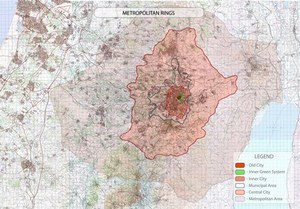The Jerusalem Metropolis
Jerusalem 5800 intends to maximize the potential economic growth by including plans for Jerusalem’s surrounding areas, resulting in a metropolis as opposed to simply a city.
A basic assumption for designing optimal function of the Jerusalem metropolis as an urban space is the free movement of people and merchandise, regardless of the population distribution and political arrangements. The outer, extended metropolitan area in the Jerusalem 5800 plan is delineated by the Jerusalem district to the west, the Dead Sea to the east, Ramallah and Beit El to the north, and Bethlehem and the Etzion Bloc to the south.
The greater metropolis is divided into five peripheral rings: The Old City (Holy Basin), municipal boundaries, ‘inner ring’ including of Ma’ale Adumim to the east and Bethlehem to the south, the ‘middle ring’ extending to Bet Shemesh in the west, and an ‘outer ring’.

In the center, the Holy Basin is Jerusalem’s and arguably Israel’s principle tourist anchor. Original Jerusalem was the City of David and Gihon spring which later expanded to include the Temple Mount and the Western Hill. The Old City and its environs are bordered by the Kidron Valley on its east, and the Ben Hinnom Valley on the west and south in which structures were built during the 19th century CE. These valleys, as well as the area north of the city, are natural depressions that stretch in a radius of 3 to 4 kilometers around the Old City.
A second belt surrounds the inner city band in which independent villages are located. These villages – in certain cases ‘satellite towns’ are a one to two hour walk from the city; including, for example, Bet Lehem, Ein Kerem, Motza, Abu Ghosh and e-Nebi Samwil. Each of these is a separate, independent tourist center with a very rich archaeological environment.
Jerusalem 5800′s master plan for tourism will emphasize the archaeological sites in the city and the areas surrounding it; these are very important both for the visitor who is interested in Jerusalem itself, and for the general public looking for a unique travel experience. The basin of the ancient city and its surrounding valleys is central to the plan for Jerusalem, including all important archaeological sites found in the city.


